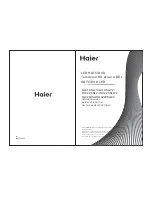
GRUNDIG Service
5
CUC 5302 ASIS
Schaltungsbeschreibung / Circuit Description
Die ASIS-Software wird in ein EEPROM geladen. Dort befindet sich in
einem geschützten Adressbereich eine Bootsoftware. Diese ver-
gleicht die vom ASIS-PC angebotene ASIS-Softwareversion mit der
bereits vorhandenen. Bei fehlender Übereinstimmung fordert die
Bootsoftware über das Antennennetz die aktuelle ASIS-Software vom
ASIS-PC an und speichert diese im überschreibbaren Adressbereich
des EEPROMs ab. Mittels Lötbrücken auf dem ASIS-Modul kann
dieses für die Verwendung von EPROMs und EEPROMs konfiguriert
werden.
Das Uhrmodul
Die Uhr ist nun in jedem ASIS-Fernseher mit CUC 6301 vorhanden.
Der ASIS-Prozessor schickt die nötigen Daten über einen eigenen I
2
C-
Bus an das Anzeigemodul. Die Uhrzeit bekommt die ASIS-Karte vom
PC gemeldet. Neben der Anzeige der Uhrzeit wird das Uhrmodul auch
für die Anzeige von Meldungen verwendet. Liegen beispielsweise
Nachrichten für den Gast vor, so kann die Anzeige blinkend das Wort
"Info" anzeigen.
Einblendung von Bildtafeln durch ASIS
Der auf der ASIS-Karte sitzende Videotext-Baustein generiert auf
Befehl des ASIS-Prozessors Bildschirmseiten. Aus der Sicht des
Fernsehers sind dies Informationen seines Videotext-Bausteins, die
über die RGB-Leitungen geschickt werden. Hat die ASIS-Karte Daten
anzuzeigen, so teilt sie das dem RGB-Baustein über die "DATA“-
Leitung mit. Während der ASIS-Videotext-Baustein die RGB-Informa-
tionen liefert, versorgt er auch das Amplitudensieb mit dem Sync.
Externe Schnittstellen zu ASIS
ASIS bietet die Möglichkeit, externe Signale an einem Sensoreingang
zu verarbeiten. Bisher ist jedoch nur ein Anschluß für einen Rauch-
melder realisiert. Gibt der angeschlossene Rauchmelder Alarm, so
teilt die ASIS-Karte das der Zentrale unter Angabe der Zimmernummer
mit. Von der Zentrale können nun geeignete Maßnahmen eingeleitet
werden.
Ein I/O- Anschluß ist für zukünftige Anwendungen vorgesehen, wird
jedoch derzeit nicht genutzt. Denkbar wäre hier beispielsweise eine
Signallampe, eine Alarmsirene, ein Panikschalter oder Notrufsystem
für alte Menschen und Behinderte usw.
Das Bedienteil
Mikrocomputer
Der maskenprogrammierte 8 Bit Mikrocomputer IC811 auf dem Chas-
sis decodiert die vom Hauptrechner auf dem ASIS-Baustein selektier-
ten Daten und steuert den Systemablauf. Diese ausgesuchten Infrarot-
signale gelangen vom "IR OUT" Ausgang des ASIS-Prozessors zum
Eingang des Fernseh-Prozessors, Pin 37. Nach der Initalisierung
kommuniziert der
µ
P über den I
2
C-Bus mit dem Tuner und dem
EEPROM IC847.
Service-Hinweis:
Die I
2
C-Bus-Daten sind auch ohne Funktionsbefehl der IR-Fernbedi-
nung vorhanden. Messen Sie auf der Datenleitung keine Busaktivitäten
(Impulsfolge ca. 150ms), liegt evtl. ein Schluß vor. Zur Lokalisierung
des Fehlers werden dann nacheinander alle am Datenbus ange-
schlossenen Bausteine abgelötet, bzw. alle Baugruppen gezogen.
Den "Netz-Reset“ für den
µ
P liefert nach dem Einschalten der
Resetbaustein IC820. Dieser löst ein Zurücksetzen des Rechners
("Low" an Pin 1) bei einer Betriebsspannung von < 4,8V aus.
Die eingebauten D/A Wandler an den Analogausgängen Pin 31-35
regeln durch Änderung des Puls-Pausenverhältnises die Werte für
Kontrast, Farbe, Helligkeit, Tint und Lautstärke.
The ASIS software is stored in an EEPROM which contains a protected
address memory with a boot software. This boot software compares
the ASIS software version presented to it by the ASIS PC with the
existing software. If there is any difference between the two versions,
the boot software requests the ASIS PC via the aerial network to send
the relevant software and stores it in the address memory of the
EEPROM which can be overwritten. By means of solder bridges, the
ASIS module can be altered for the accommodation of EPROMs and
EEPROMs.
The Clock Module
The clock is now fitted to all ASIS TV receivers with CUC 6301. The
ASIS-processor transmits the necessary data on a separate I
2
C-bus to
the display module. The ASIS-card obtains the clock time from the PC.
Apart from the clock time, the clock module is also used to display
messages. For example, if there is any message for a guest, the
indication "Info" flashes in the display.
Insertion of text tables with ASIS
A videotext module is located on the ASIS card to generate text tables
on the orders of the ASIS-processor. The TV receiver interpretes this
information as data from its videotext module transmitted via the RGB
lines. If data are present for transmission, the ASIS-card informs the
RGB-module via the "DATA“ line. During the time the ASIS videotext
module supplies the RGB information it also supplies the sync to the
amplitude filter.
External Interfaces to ASIS
ASIS offers the possibility of processing external signals at a sensor
input. Up to the present time only a connection for a smoke detector has
been realized. When a smoke alarm is given the ASIS-card informs the
central office with indication of the room number. The central office can
then take appropriate measures.
An I/O- connection is provided for future applications but it is not yet
being used. Possible applications are, for example, a signal lamp, a
warning siren, a panic switch or emergency call system for old and
handicapped people etc.
Keyboard Control Unit
The Microcomputer
The mask-programmed 8 Bit microcomputer IC811 on the chassis
decodes the data selected by the main processor on the ASIS-module
and is responsible for the system control. These selected infra-red
signals are passed on from the "IR OUT" output of the ASIS-processor
to the input of the TV-processor, Pin 37. After the initialization, the
microcomputer communicates via the I
2
C-bus with the tuner and the
EEPROM IC847.
Service Note:
The I
2
C-bus data are also present without command from the IR
remote control handset. If no data are carried on the bus lines (pulse
rate approx. 150ms), there may be a short circuit. To localize the short
circuit, the ICs connected to the data bus must be unsoldered and the
modules unplugged one after the other.
The "Reset“ pulse for the
µ
P is obtained from the Reset circuit IC820
when switching the receiver on. The reset for the processor ("Low" at
Pin 1) is released at an operating voltage < 4,8V.
The D/A converters at the analog outputs, Pins 31-35, are provided to
adjust the contrast, colour, brightness, tint and the volume level by
changing the pulse to space ratio.




































